I think Japan still would have invaded the Soviet Union though, if the Second Sino-Japanese War continued (the oil embargo only really happened once they invaded Indochina).
Other than that I agree with you. That would be curious alternate reality.
January 31, 1942. Eastern Front
The weather on the Eastern Front on 31 January 1942 is horrible, with snowstorms that close roads throughout the sector. However, some German and Soviet formations have remained on the move through the worst of it, or at least some key elements have. The Soviets are trying to encircle German formations tied to strongpoints along their old front lines both by the weather and Hitler’s firm orders to stand fast. The German-held towns are easy to encircle, but at least they provide some shelter from the blizzards. Elsewhere, the Wehrmacht is simply trying to block the worst of the Red Army advances while allowing them to occupy empty space. These conflicting strategies come into play today when the irresistible force of the Red Army is met by the immovable object of the German Army.
In the German Army Group South (von Kleist) sector, the Soviet 57th and 9th Armies and some cavalry corps have moved behind the front line of the German 17th Army (General Hoth). Hoth is holding the line in the centre of the Army Group South sector, with Sixth Army to his north and First Panzer Army to his south and down to the Sea of Azov. The Soviet breakthrough has taken place in the northern part of Hoth’s line, and the Red Army is trying to use two cavalry corps (I and V) to head south to the coast. This would effectively encircle two German Armies and blow a huge hole in the front.
However, Hoth’s men have found a copy of the Soviet plan on a dead Red Army officer. Thus, they know that the Soviet cavalry is heading for the coast. There’s only one problem, and that is the complete absence of any Wehrmacht troops to block them. Kleist thus has ordered the “Von Mackensen” Group, a mixed force under the command of General von Mackensen (commander of III Corps) that is composed of the 14th Panzer Division, 100th Light Division, and Panzer Detachment 60, to intercept the fast Soviet cavalry. The fate of Army Group South rests on von Mackensen getting into position to block the Soviet advance before the Red Army cavalry opens a road for the two following Soviet armies. For three days, the Mackensen Group struggles through the bitter landscape.
Today, the issue is decided. Using any means available in blinding snowstorms, von Mackensen’s Group arrives just in time to block the road south before the Soviet cavalry can get through. Fortunately for the Germans, the Soviet tanks have fallen behind in the horrible conditions, leaving more vulnerable Red Army cavalry units unsupported in the lead. The most mobile elements of the von Mackensen Group, Panzer Detachment 60 and 14th Panzer Division attack the leading Soviet elements about forty miles south of Barvenkovo. The Red Army tanks have lagged behind on the poor roads, so the German tank forces defeat the Soviet troops on their horses and send them reeling. This leads to an extended battle in zero-degree weather, with both sides gradually feeding in reinforcements but the Germans always holding the advantage because they only have to hold the ground, not take new ground in the Arctic like conditions.
Source: worldwartwodaily 
@captainwalker
this is one of your best ones. I’d never heard of this.
1 February, 1943
T-34s on the main square of Stalingrad, a six-barrel Nebelwerfer mortar standing by.
While the last fighting goes on in the industrial district, the city center is cleared of German troops. Victory is near.
February 2, 1942. Eastern Front
The winter has bent but not quite broken the Wehrmacht, and by 2 February 1942 it is fighting back to protect its most vital arteries. The Rollbahn, a major (for Russia) road from Yukhnov to Gzhatsk, is the lifeline to Fourth Army in the Moscow sector, and the Soviets have held it for a week. The Germans now are fighting furiously from either end of the road to open it up, with General Heinrici sending his Fourth Army troops south and General Ruoff advancing with his Fourth Panzer Army vehicles north toward him. They make good progress today, though they do not quite close the gap and reopen the road yet. There are supplies waiting behind Ruoff’s forces to be sluiced through the moment the road is cleared. This is one of the most important operations of the winter because until the road is cleared, the Fourth Army must rely on air support. The Luftwaffe already is hard-pressed supplying surrounded garrisons at Kholm, Demyansk, and elsewhere, so clearing the road is a top priority.
As the Germans regain their footing on the Eastern Front, their ambitions begin to expand again. General Dietl, commanding the Army of Lapland, is trying to convince the Finns to participate in an attack to cut the Soviet railway line to Murmansk at Belomorsk. Marshal Mannerheim, commanding all Finnish forces, is noncommittal but indicates that he would be ready to participate in such an operation once the Germans capture Leningrad. Of course, the Germans have no hope of capturing Leningrad anytime soon due to their difficulties on the main front and pretty much everyone knows that. German General Waldemar Erfurth, who leads the German liaison team at Mannerheim’s headquarters, reports back to OKW that Mannerheim has a pessimistic view of the war and is unwilling to stage any attacks that he has any chance of losing. Mannerheim prepares a letter to General Keitel today which basically expresses these views. The Germans have no alternatives in the northern sector of the front and are at Mannerheim’s mercy.
Source: worldwartwodaily 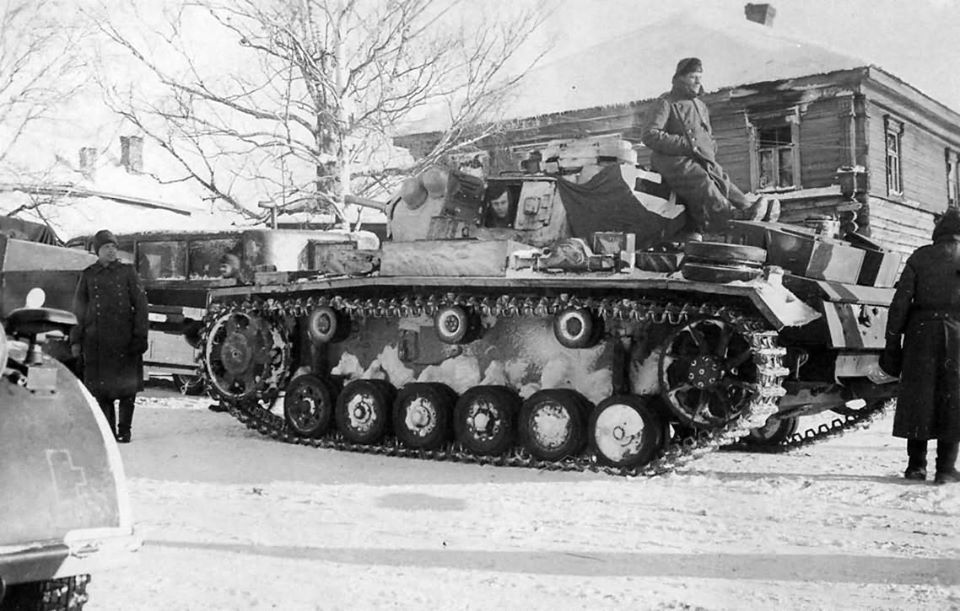
February 2, 1943 Battle of Stalingrad ends!
At four in the morning, General Strecker was informed that one of his own officers had gone to the Soviets to negotiate surrender terms. Seeing no point in continuing, he sent a radio message saying that his command had done its duty and fought to the last man. He then surrendered.
The northern pocket of the German 6th Army, trapped at Stalingrad, surrenders. In total, the Red Army has taken about 90,000 prisoners. Later, the Soviets announce that 147,000 Axis, and 47,000 Soviet corpses have been removed from Stalingrad. Furthermore, an estimated 40,000 were evacuated during the air supply operations conducted by the Germans, during the siege. The Luftwaffe lost about 500 transports. Only 5000 Germans taken prisoner survive to return to Germany after the war; the last to return arrives in 1955. The Soviet success is generally attributed to General Chuikov’s leadership and tactical innovation.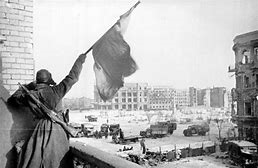
February 3, 1942. Eastern Front
The Germans achieve a major success on 3 February 1942 when they clear the vital supply road to Fourth Army that runs from Yukhnov to Gzhatsk. German XII Corps and the 20th Panzer Division blast their way through Red Army roadblocks and “bridge the gap,” thereby allowing resupply to the beleaguered army. There are Soviet forces on either side of the road - Soviet Thirty-third Army to the west and Forty-third Army to the east - and the corridor (which includes the nearby railway line) is only a few miles wide in places. However, for the first time in over a week, General Heinrici’s Fourth Army can get the supplies that it needs to survive. Now, the Soviets to the west of the corridor begin to worry that they may be the ones who are trapped. However, German strength along the Rollbahn (as the Germans call the road) is very weak, and supply convoys must have armed escorts to fight their way through at times.
In Finland, General Mannerheim sends a letter in response to a German request that Finnish forces resume an advance toward the Murmansk railway line. It says that Finnish troops would be unavailable to advance toward Belomorsk, the chosen point of attack, during the winter. The letter leaves few doubts in German minds that Mannerheim has become pessimistic about the course of the war and is unlikely to mount any offensive operations until the Red Army is basically defeated.
Luftwaffe ace Rolf Kaldrack (24+ victories, 3 in Spain) is killed in his Messerschmitt Bf 110 E-1 “S9+IC” (Werksnummer 4057 (factory number)) south of Toropets when his plane collides with a Mig-1 that he or his gunner (Unteroffizier Enke, also killed) had just shot down. He posthumously is awarded the 70th Oak Leaves to the Knight’s Cross of the Iron Cross.
Source: worldwartwodaily 
@captainwalker said in On this day during W.W. 2:
1 February, 1943
T-34s on the main square of Stalingrad, a six-barrel Nebelwerfer mortar standing by.
While the last fighting goes on in the industrial district, the city center is cleared of German troops. Victory is near.!
In another indication of approaching victory, Friedlich Paulus had surrendered the previous day, the same day on which Hitler promoted him (by radio) to the rank of Field Marshall. The promotion wasn’t exactly in congratulations for a job well done: no German field marshall had ever been taken alive, and Hitler – who wasn’t known for his subtlety – therefore expected Paulus to shoot himself. Paulus declined the implied suggestion.
February 4, 1942. Eastern Front
The Wehrmacht continues its painful attempt to restore its front, or at least communications to its most isolated units, on 4 February 1942. The Rollbahn between Yukhnov and Gzhatsk has been cleared, restoring access to the Fourth Army, but many other large units remain blocked from receiving supplies. In the most important movement today, Ninth Army’s 46th Panzer Corps advances through blizzards from Sychevka toward Rzhev in order to establish another line of communications to the Fourth Army. If it succeeds in this 30-mile advance, it will create a line in the northwest that will trap large Soviet forces west of the Rollbahn in its own pocket. The Germans optimistically hope to confine and eliminate Soviet 39th Army in this area southeast of Rzhev, but the German hold is weak everywhere and a focused Red Army effort in virtually any direction would at the very least enable the Soviet troops to break out. However, the Stavka is not interested in breakouts at this time and the Red Army local commanders hold a large swathe of territory in which they receive air supply and also supplies through the porous front. It is a peculiar situation in which both sides consider themselves, with some justification, to be on the offensive, only operating in different directions.
Source: worldwartwodaily 
February 3, 1944 Eastern Front
In Moscow… The encirclement of German forces in the Korsun pocket is announced and celebrated.
From Berlin… Hitler orders the troops in the Korsun pocket are not to retreat.
Army Group South (Manstein) assembles an armored force to relieve the Korsun pocket.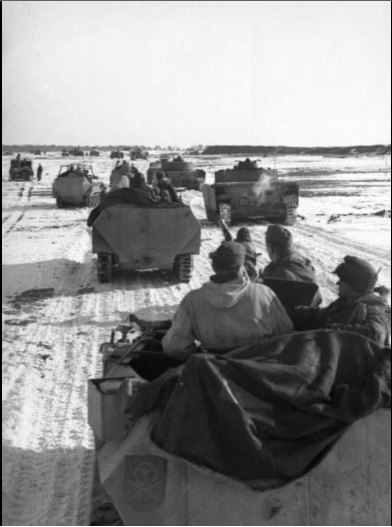
man, i bet they weren’t too enthusiastic to be taking part in that. That just looks, well…not good
@barnee Yeah, that doesn’t look like a very good time…
The Tol Plantation Massacre - 4th February 1942
Rabaul was the capital of Australian-mandated New Guinea and was protected by a tiny garrison consisting mainly of the 2/22nd Australian Bn - “Lark Force”.
The town was quickly routed by a massive Japanese fleet of carriers, destroyers, submarines and fighter and bomber aircraft.
When the order “every man for himself” was given, soldiers and civilians fanned out over New Britain looking for escape routes through the most rugged terrain imaginable.
Some endured an epic trek through dense jungle, battling malaria, dysentery, tropical ulcers, leeches, exhaustion, malnutrition and crocodile-infested rivers, to eventually reach points where they were able to escape on small boats.
But this was not the majority, including those who reached Tol Plantation hoping to be rescued.
To their horror, five barge-loads of Japanese troops were on the beach to meet them.
There was no option for the starving, exhausted, virtually unarmed Australians but to surrender. At first it seemed they would be treated as normal PoW’s. Then an order to execute the PoW’s was given.
Red Cross brassards were ripped off medics. Men were trussed together in small groups with fishing line or ropes and taken into the jungle and slaughtered.
They stood or sat listening to their mates’ death cries, awaiting their own fate by blade or bullet.
The few survivors told of grinning Japanese soldiers emerging from the bush wiping blood from their bayonets and beckoning their next targets.
Some victims were asked if they wanted to be shot or bayoneted, a majority chose to be shot only to be bayoneted. Two wounded men found alive in Waitavalo Plantation homestead had been smeared in pig grease to be burned alive in the house.
Requests for final cigarettes were refused. Some men prayed, some begged for their lives, others said cheerio to their mates.
They were covered in palm leaves and left to die. Incredibly, several men feigned death and survived to tell the story.
Pte Billy Cook, 2/12 Australian Field Ambulance survived 11 bayonet wounds. He wrote:
“The first stab knocked us down. The Japs stood over us stabbing madly. I received six wounds in the back, two just missing the spine, two more breaking ribs…
“As the Japanese were moving off, the man next to me groaned. One of the Japanese soldiers came running back and stabbed him once more. By this time I could hold my breath no longer. When I drew a deep breath the soldier heard me and inflicted four more bayonet wounds.
“The last thrust went through my ear into my mouth, severing an artery on the way. Seeing the blood gushing out of my mouth, he assumed that I was at last dead, he covered the three of us with coconut fronds and vine leaves and left.”
Cook somehow crawled off into the jungle, as did five other survivors, and eventually was evacuated from New Britain to Port Moresby with 156 soldiers, sailors and civilians aboard the overcrowded government yacht, the Laurabada.
Approximately 160 members of “Lark Force” were massacred.
An estimated 1,053 of the troops and Rabaul residents who remained in the town or who were captured would eventually perish as prisoners when their prison ship, the Montevideo Maru, taking them to Hainan then occupied by Japan, was sunk by mistake by a US submarine " USS Sturgeon", off the Philippines on the 1st July 1942.
After the war some remains were retrieved, and buried at Rabaul’s beautiful Bita Paka war cemetery, but the bones of others are still in the jungle soil of a place whose name most Australians and British have never heard of.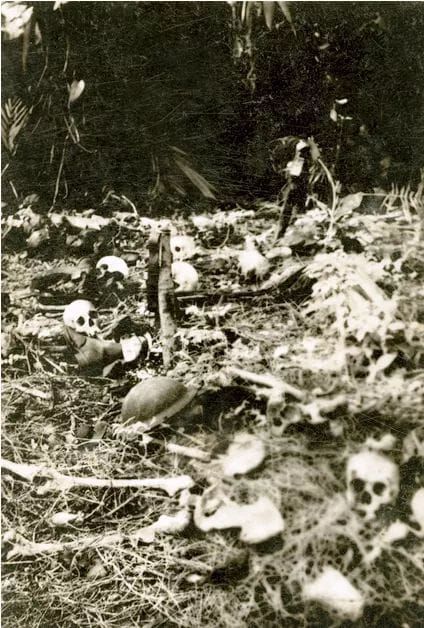
On this day in 1944, Field Marshal Manstein begins his relief attempt to break the Korsun–Cherkasy Pocket.
Six German divisions were surrounded. Though many trapped men escaped, they had to leave nearly all of their equipment behind, with heavy losses.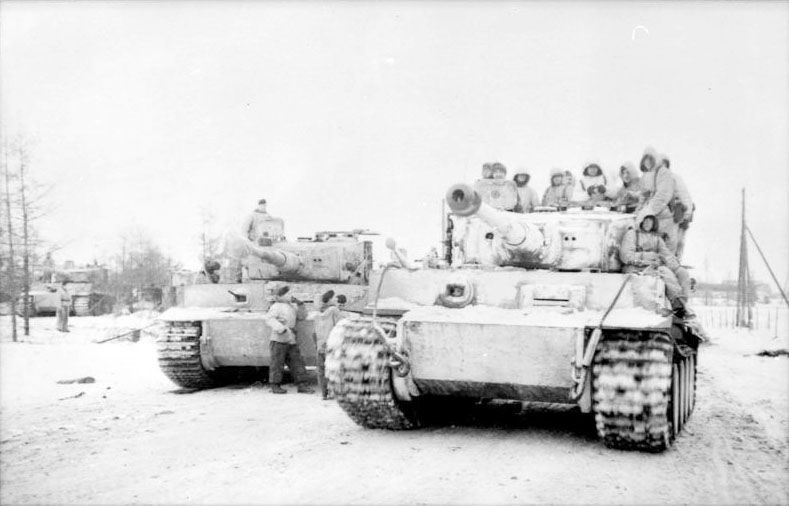
@captainwalker said in On this day during W.W. 2:
On this day in 1944, Field Marshal Manstein begins his relief attempt to break the Korsun–Cherkasy Pocket.
Six German divisions were surrounded. Though many trapped men escaped, they had to leave nearly all of their equipment behind, with heavy losses.
Interesting. This engagement sounds like an Eastern Front counterpart to the Falaise Gap engagement on the Western Front, in August of the same year. A similar number of German troops were encircled, and like the ones at Cherkasy-Korsun they left vast amounts of equipment behind in order to escape.
yea actions such as those is why I have no problem with japan being nuked
February 6, 1942. Eastern Front
The Germans have avoided disaster by reopening supply lines to the Fourth Army and other large formations that were isolated by the Soviet counteroffensive around Moscow in December and January 1942. However, large forces remain surrounded at Kholm and Demyansk and there are no plans to relieve them anytime soon. Instead, the Germans have decided to supply them by air in the first sustained airlift in military history. Hitler is solidly behind this idea, though his underlings sometimes advise him that the planes could be better used elsewhere and the pockets are unsustainable. The airlift is hampered by the absence of airfields, so many of the supply efforts must be made by airdrops. These drops are not always accurate, and fierce battles develop as both sides attempt to recover the crates in the contested fringe areas. Overall, though, the airlift idea works, though life inside the pockets is grim and the defences barely hold. The Red Army also has troops behind German lines, most notably south of Rzhev, and they, too, survive only with airlifts. There Germans are astonished to see the Red Air Force transports landing within view and in all kinds of weather.
Source: worldwartwodaily
February 7, 1942. Eastern Front
Soviet counteroffensive is running out of steam in a series of ragged engagements west of Moscow. German Gruppe Scherer continues to hold Kholm, supplied by airdrops, in the rear of Soviet 3rd Shock Army which is held up at the town of Velikie Luki. Germans hold a giant salient from Vyazma to Rzhev but Soviet infantry, cavalry and parachute attacks all fail to cut the supply route through Vyazma. Moreover, Model’s German 9th Army at Rzhev has cut off Soviet 29th and 39th Armies, which were themselves trying to surround Rzhev.
Siege of Leningrad Day 153. Soviet offensive northwest of Moscow to relieve Leningrad is also stalling out. Germans hold another salient south of Lake Ilmen, from their railhead at Staraya Russa to Demyansk. Soviet 11th Army, 34th Army, and 3rd Shock Army press in on the German defences.
After a month of vicious fighting, Finnish II Army Corps (General Laatikainen) recovers the town of Krivi, Maaselkä Isthmus (north of Lake Onega), from the Soviet 367th Rifle Division. Finnish reinforced 19th Brigade (Col. Kai Savonjousi) leads the final charge. The battle begins at 03:00 and lasts until 14:45. There are at least 4000 Soviet dead and only 152 prisoners, while the Finns lose 12 missing or killed. Further south, Soviet ski troops attack the town of Poventsa (Povenets) but are pushed back. These actions restore the Finnish lines from before the Red Army’s winter offensive and secure the Finnish eastern flank north of the lake.
Source: worldwar2daybyday and worldwartwodaily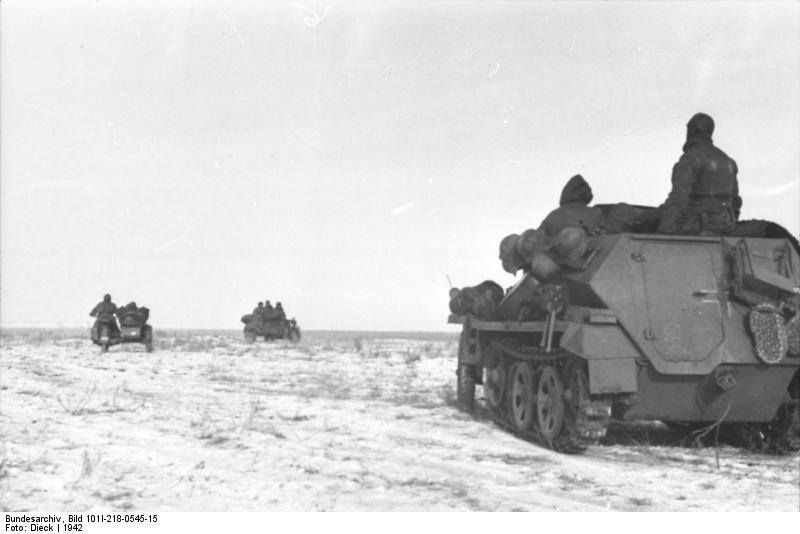
February 8, 1942. Eastern Front
While the German troops in Demyansk have been isolated for some time, 8 February 1942 is regarded as the date on which the pocket there forms. The Soviets are under the command of General Kurochkin. Encircled are about 90,000 Wehrmacht troops and around 10,000 auxiliaries under the command of II Corps (General Walter von Brockdorff-Ahlefeldt). These men are members of the 12th, 30th, 32nd, 123rd and 290th infantry divisions, and the SS Division Totenkopf, as well as the Reich Labour Service, Ordnungspolizei (uniformed police), Organisation Todt, and other auxiliary units. Many have been swept into the pocket by the advance of the Soviet Northwest Front under the command of General Lieutenant Pavel Kurochkin.
The Red Army successfully has severed the Demyansk position, which has been forbidden to withdraw due to Hitler’s “stand fast” orders, from its railhead at Staraya Russa south of Lake Ilmen. While the Soviet advance has severed the German lines of communication, it has not captured any major German fortified positions, and eliminating the Demyansk pocket turns into their best chance to do that. The Luftwaffe already has an air supply to Demyansk in progress under the command of Luftflotte 1. Unlike some later and notorious airlifts, the Demyansk airlift (and the contemporaneous one to the smaller trapped garrison about 62 miles (100 km) to the south at Kholm) is successful. This is because it benefits from relatively short flights and a lack of concentrated Red Army anti-aircraft fire in the forested areas surrounding the pocket.
Photo: A Soviet Aerosan RF-8/GAZ-98 snowmobile in action, February 1942.
Source: worldwartwodaily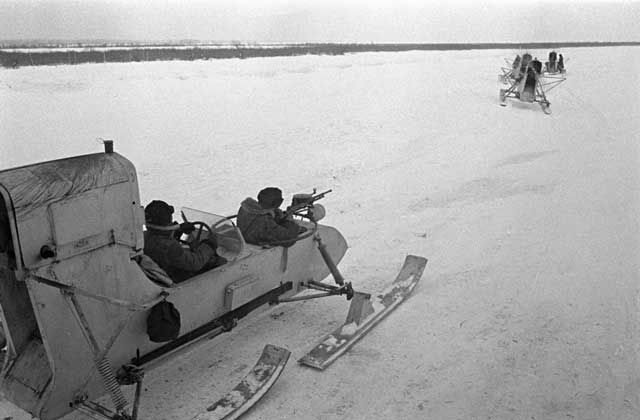
cool looking snomobile. Can’t tell how it propels itself though
@barnee It’s got a propeller in the back of it. Kind of like a swamp buggy, but for snow.